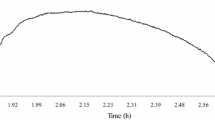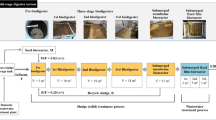Abstract
The aim of this work is to evaluate the performance of a submerged membrane bioreactor that operated continuously for 200 days and to assess biomass activity and membrane fouling under various operating conditions. Furthermore, a method for the characterisation of biomass activity is developed based on its separation into various fractions. Respirometry and Activated Sludge Models are used as biological process to identify active biomass and species of activated sludge. However, the equations describing the active biomass are developed. The submerged membrane bioreactor system operated at the solids retention times of 40 and 60 days with organic loading rate of 0.5635 kg/COD/m−3/day−1 and chemical oxygen demand/nitrogen ratio of 3.5. Activated sludge is generated in a system fed with soluble and easily biodegradable substrate [ethanol/sodium acetate (1:1)], this synthetic wastewater, containing no hardly biodegradable organic or inorganic particulate matter, has led to the generation of a sludge constituted essentially of two fractions: active biomass and cell debris.





Similar content being viewed by others
References
An Y, Wu B, Wong FS, Yang F (2010) Post-treatment of up flow anaerobic sludge blanket effluent by combining the membrane filtration process: fouling control by intermittent permeation and air sparging. Water Environ J 24:32–38
APHA, Awwa and WEF. (1998) Standard methods for the examination of water and wastewater, 20th edn. APHA, Washington, DC
Benaliouche H, Abdessemed D, Nezzal G (2013) The effects of operation conditions of carbon/nitrogen ratio and pH on nitrogen removal in intermittently aerated membrane bioreactor (IAMBR). Desalination Water Treat 51:1057–1062
Capodici M, Corsino S, Di Pippo F, Di Trapani D, Torregrossa M (2016) An innovative respirometric method to assess the autotrophic active fraction: application to an alternate oxic–anoxic MBR pilot plant. Chem Eng J 300:367–375
Chang J, Liang W, Xiao E, Wu Z (2011) Effect of intermittent aeration on the microbial community structure of activated sludge in a submerged membrane bioreactor. Water Environ J 25:214–218
Di Bella G, Di Trapani D, Torregrossa M, Viviani G (2013) Performance of a MBR pilot plant treating high strength wastewater subject to salinity increase: analysis of biomass activity and fouling behavior. Bioresour Technol 147:614–618
Di Trapani D, Capodici M, Cosenza A, Di Bella G, Mannina G, Torregrossa M, Viviani G (2011) Evaluation of biomass activity and wastewater characterization in a UCT-MBR pilot plant by means of respirometric techniques. Desalination 269:190–197
Fenu A, Guglielmi G, Jimenez J, Sperandio M, Saroj D, Lesjean B, Brepols C, Thoeye I, Nopens C (2010) Activated sludge model (ASM) based modeling of membrane bioreactor (MBR) processes: a critical review with special regard to MBR specificities. Water Res 44–15:4272–4294
Garcia-Ochoa F, Gomez E, Santos V, Merchuk J (2010) Oxygen uptake rate in microbial processes: an overview. Biochem Eng J 49:289–307
Gianpaolo S, Marco F, Alessandro S (2013) Effect of solid retention time on sludge filterability and biomass activity: long-term experiment on a pilot-scale membrane bioreactor treating municipal wastewater. Chem Eng J 221:176–184
Grelier P, Rosenberger S, Tazi-Pain A (2006) Influence of sludge retention time on membrane bioreactor hydraulic performance. Desalination 192:10–17
Henze M, Van Loosdrecht MCM, Ekama GA, Brdjanovic D (2008) Biological wastewater treatment: principles, modeling and design. IWA Publishing, London, pp 112–139
Ince M, Senturk E, Onkal Engin G, Keskinler B (2013) Landfill leachate treatment in jet-loop membrane bioreactor operated under different organic loading rates. Int J Environ Res 7:727–734
Ittisupornrat S, Tobino T, Yamamoto K (2015) Effect of sludge retention time on inclined plate function, treatment performance and sludge characteristics of inclined plate membrane bioreactors treating municipal wastewater. Water Environ J 29:346–352
Judd S (2010) The MBR Book: principles and applications of membrane bioreactors for water and wastewater treatment. Elsevier, Amsterdam
Le-Clech P, Chen V, Fane A (2006) Fouling in membrane bioreactors used in wastewater treatment. Membr Sci 284:17–53
Lobos J, Heran M, Grasmick A (2009) Optimization of the operations conditions in membrane bioreactors through the use of ASM3 model simulations. Desalination Water Treat 9:126–130
Mahmoudkhani R, Hassani AH, Torabian A, Borghei SM (2012) Study on high-strength anaerobic landfill leachate treatability by membrane bioreactor coupled with reverse osmosis. Int J Environ Res 6:129–138
Manser R, Muche K, Gujer W, Siegrist H (2005) A rapid method to quantify nitrifiers in activated sludge. Water Res 39:1585–1593
Meng F, Yang F, Shi B, Zhang H (2008) A comprehensive study on membrane fouling in submerged membrane bioreactors operated under different aeration intensities. Sep Purif Technol 59:91–100
Orhon D, Artanand N, Cimsit Y (1989) The concept of soluble residual product formation in the modeling of activated sludge. Water Sci Technol 21:339–350
Philippe N, Stricker A, Racault Y, Husson A, Sperandio M, Vanrolleghem P (2013) Modeling the long-term evolution of permeability in a full-scale MBR: statistical approaches. Desalination 325:7–15
Radjenovic J, Matosic M, Mijatovic I, Petrovic M, Barcelo D (2008) Membrane bioreactor (MBR) as an advanced wastewater treatment technology. In: the handbook of environment chemical
Rahman MM, Al-Malack MH (2012) Biochemical kinetics of cross flow membrane bioreactor processes in the treatment of refinery wastewater. Int J Environ Res 6:285–296
Ramdani A, Dold P, Gadbois A, De´le´ris S, Houweling D, Comeau Y (2012) Characterization of the heterotrophic biomass and the endogenous residue of activated sludge. Water Res 46:653–668
Rodríguez FA, Poyatos JM, Reboleiro-Rivas P, Osorio F, González-López J, Hontoria E (2011) Kinetic study and oxygen transfer efficiency evaluation using respirometric methods in a submerged membrane bioreactor using pure oxygen to supply the aerobic conditions. Bioresour Technol 102:6013–6018
Shahbeig H, Mehrnia MR, Mohammadi AR, Moghaddam PE, Rouini MR (2017) Pharmaceutical wastewater treatment using membrane bioreactor-ozonation system. Water Environ J 31:57–63
Shariati FP, Heran M, Sarrafzadeh MH, Mehrnia MR, Sarzana G, Ghommidh C, Grasmick A (2013) Biomass characterization by dielectric monitoring of viability and oxygen uptake rate measurements in a novel membrane bioreactor. Bioresour Technol 140:357–362
Stricot M, Filali A, Lesage N, Sperandio M, Cabassud C (2010) Side-stream membrane bioreactors: influence of stress generated by hydrodynamics on floc structure, supernatant quality and fouling propensity. Water Res 44:2113–2124
Sungsoo H, Bae T, Gug G, Tae J, Tak M (2005) Influence of sludge retention time on membrane fouling and bioactivities in membrane bioreactor system. Process Biochem 40:2393–2400
Villain M, Marrot B (2013) Influence of sludge retention time at constant food to microorganisms ratio on membrane bioreactor performances under stable and unstable state conditions. Bioresour Technol 128:134–144
Yang Y, Lesage G, Barret M, Bernet N, Grasmick A, Hamelin J, Heran M (2014) New urban wastewater treatment with autotrophic membrane bioreactor (AutoMBR) at low COD/N substrate ratio. Water Sci Technol 69(5):960–965
Zuthi MFR, Ngo HH, Guo WS, Nghiem LD, Hai FI, Xia SQ, Zhang ZQ, Li JX (2015) Biomass viability: an experimental study and the development of an empirical mathematical model for submerged membrane bioreactor. Bioresour Technol 190:352–358
Author information
Authors and Affiliations
Corresponding author
Rights and permissions
About this article
Cite this article
Benaliouche, H., Abdessemed, D., Lesage, G. et al. Characterization of Active Biomass and Species by Means of Respirometric Technique from Activated Sludge Models. Int J Environ Res 11, 489–500 (2017). https://doi.org/10.1007/s41742-017-0043-1
Received:
Revised:
Accepted:
Published:
Issue Date:
DOI: https://doi.org/10.1007/s41742-017-0043-1




